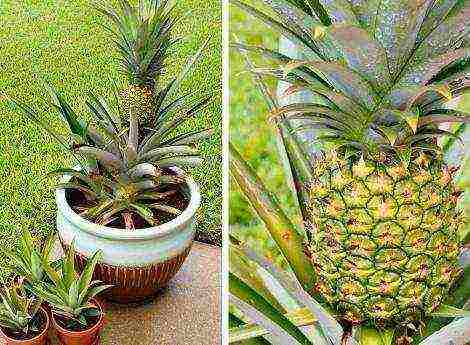Content

"Flower of sorrow" - this is how the ancient Greeks called hyacinth, modern florists consider it a flower of "love and fidelity". All this is about him - about fragrant hyacinth. Today modern florists are sharing their experience on how to grow hyacinths in open ground, flowerpots and even on the windowsills of small apartments.
Growing hyacinths outdoors
An incredible, intoxicating smell, a variety of shades of inflorescences, ease of care and a relatively long flowering period, in relation to an affordable price, makes hyacinth flowers a feminine favorite. Planting and caring for lovely buds in the garden is one of the most enjoyable jobs of amateur flower growers.
Millions of pots of hyacinths are sold throughout the country for the favorite spring women's holiday and not only. Having delighted the owner for some time, giving her all its color and aroma, the hyacinth withers, leaving a small onion in memory of itself. And, of course, you should not throw away the faded plant. It is much more prudent to prepare and transplant the bulb into open ground. And again and again enjoy its unique spring bloom. Moreover, hyacinth is one of the favorite early folk primroses.
What land is needed for hyacinth
Before starting planting, it is important to select the right soil. The most suitable for a bulbous plant will be loose soil that allows water to pass through with ease. The ideal option will be obtained if such land is additionally enriched with mineral fertilizers. For this, both a purchased packaged product and ordinary humus are suitable, which is introduced into the soil to a depth of 30 to 40 cm.The only thing you need to pay attention to in this case is that the soil for hyacinths with the help of mineral fertilizers should be prepared in advance, ideally , a couple of months before planting.
Does hyacinth love sun or shade?
An unpretentious plant can be grown both in areas open to sunlight and in slightly shaded places. Do not plant bulbs under bushes or close to trees, the root system of the latter can drown out the growth of flowers. The most important thing is to protect the bulbous plants from drafts and constant gusts of wind. It is worth paying attention to the possibility of water stagnation at the landing site. Like any bulbous plants, hyacinth does not like excess moisture; a constantly wet bulb can simply rot. Therefore, if in doubt, it is better to plant flowers on a small hill or on a slope, in which case the water will definitely seep below the planting level and heavy rainfall will not harm them.
When to plant hyacinths in the ground
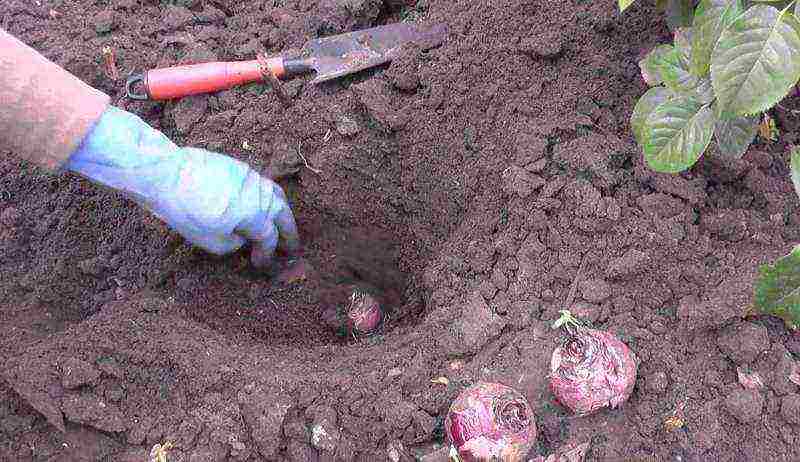
Having learned in advance how to plant hyacinth in the ground, you can avoid the typical mistakes of novice gardeners. So, the main directions in landing:
- soil preparation begins 2 months before planting, that is, in the month of August; the earth is fertilized with minerals, bend, loosening from time to time;
- planting time and how to plant hyacinths in the fall in open ground - in September - early October (before the soil freezes), they begin directly planting the bulbs. If you start planting ahead of time, the bulb will grow and simply ... freeze. The flowering period of hyacinths in the open field: April - March, they will not be able to hatch through a snowdrift. So, having made a depression in the ground (15 cm will be enough) with a garden trowel, you can start planting. The flowers themselves must keep a distance of at least 20 cm between themselves in the flower bed;
- bulb care. The main thing to remember here after planting is to make sure that the bulbs do not freeze over the winter. Sawdust, fallen leaves, dry peat and other mulching materials, both organic and inorganic, will help prevent this.
Attention! If the soil has not been fertilized beforehand, it is recommended to sprinkle the bottom of the hole with sand mixed with peat or rotted compost.
Hyacinth care in the garden
When planting is complete, you can forget about the bulbs until they start growing. It was when a young bore appeared, and feeding and watering of the plant began. Ammonium nitrate and superphosphate are quite suitable for the first feeding. You can simply sprinkle the substances in the dose indicated on the package, and then, loosening the ground with a garden glanders, water the soil.
How to water hyacinths in the garden
After planting, the question may immediately arise: how often to water the hyacinth? At home, everything is clear: you just need to make sure that the soil does not dry out and water the pot from time to time to the top with settled water at room temperature. In the garden, rainfall regulates the process, frequency and temperature of water for irrigation. If there is no rain, it remains only to prevent the soil from completely drying out, especially during the flowering period, otherwise the bulb from a lack of moisture can simply throw off the inflorescences and the plant, which could please the eye for a long time, will go into hibernation until next year.
When the plant has completely bloomed and only a bulb remains in the ground, it does not need to be specially watered at all, it should lie dormant before transplanting.
If it is decided to transfer one of the plants from the summer cottage to your favorite windowsill, it is better to first place the dug out onion in a glass of water. Of course, she should not swim there, it is worth picking up a glass by size, germination of hyacinth goes like sprouting ordinary onions at home. When a green bore appears, the flower can already be planted in a full-fledged pot with soil. Of course, it is better if it is specially selected purchased soil.
How to care for hyacinths in the garden

Do not forget about mineral fertilizers (superphosphate and potassium sulfate), which are best used at the beginning of the formation of hyacinth buds. This can be done both by sprinkling the substances (in dry form), and during irrigation, diluting in water. Already in the flowering period, so-called micronutrients, such as boric acid and zinc sulfate, for example, are suitable for feeding.
How to plant hyacinths in the spring in the garden
Despite the fact that hyacinth is considered to be a primrose, you can admire its delightful flowering even later. For this, the bulbs are planted in open ground in the spring. If this season is chosen for planting, then before starting the process, the flower bulbs are recommended to be placed in the refrigerator for an hour, or rather, in the freezer. Florists call this method of planting stratification. Thus, deceptive conditions for simulating “winter cold” are created. The main thing is to do everything wisely, do not freeze the bulb for too long, otherwise it will freeze and you can not wait for flowering. When to plant hyacinths in open ground in spring, common sense and forecasters with a meteorological forecast will tell you. The soil should be warmed by the sun's rays in the spring, and the threat of frost is also unacceptable.
Ammonium nitrate and potassium will serve as fertilizers for the soil during the spring planting period. Of course, they should be used on the ground after the snow has completely melted.
In order for the roots of the plant to breathe, it is recommended to loosen the soil after spring planting from time to time with garden tools.
When the beauties of the hyacinth have faded, its bulb will again require attention and care. During this period, the soil will again need to be treated with superphosphate and potassium sulfate. The faded flower itself can be cut off higher, allowing the plant to fade in a natural way. It is not recommended to leave the bulbs in the same place every year, the earth and the flower should rest from each other for 3 years. The thing is that the soil can accumulate pests and various pathogens, and the bulbous handsome man is quite sensitive to them.
All articles about hyacinths on the site can be read by following this link ...
For a year, each planted onion gives 3-4 shoots, therefore it is not difficult to breed beautiful spring primroses! With proper care, the bulb will delight again and again with flowering and aroma.
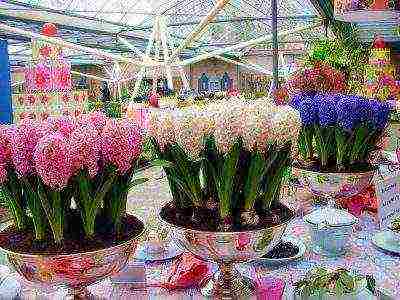
Hyacinth belongs to the lily family.
There are more than 30 types of various subspecies.
The flowers of the plant can be double, fragrant and simple.
Suitable for growing at home, garden plots, greenhouses and botanical gardens. Asia is considered the birthplace of the flower.
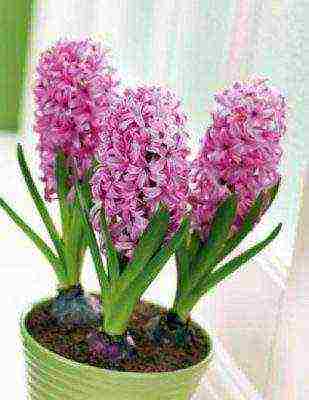 How to grow hyacinths in pots?
How to grow hyacinths in pots?
The plant prefers bright, diffused light. Dislikes cold winds and drafts.
The soil should be loose, breathable. It is necessary to add humus to the substrate.
The tanks must have a drainage system that will not allow excess moisture to accumulate. For this, expanded clay, pebbles, shards or broken brick are suitable.
After flowering, the peduncle must be cut off. At the beginning of autumn, watering and feeding is reduced to a minimum.
At the beginning of winter, the plant begins a dormant period. At this time, the leaves shrink and die off. All nutrients are transferred to the onion.
Consider how to propagate hyacinths at home. There are four breeding methods.
Reproduction of hyacinths at home using seeds should only be used for breeding new subspecies.
When planted with seeds, the plant will bloom only 6-9 years after planting.
How to grow hyacinth from seeds at home? It is best to tie the planting material in warm weather. It is necessary to select the boxes that have not yet opened.
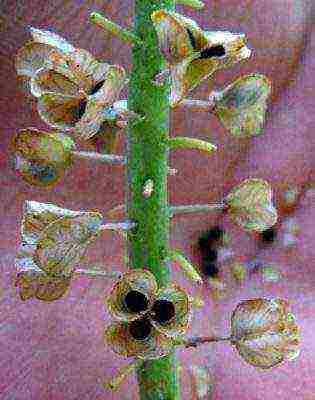 It is important that they are amber.
It is important that they are amber.
Emeralds are not recommended to be used, since they have not yet had time to ripen. A week after assembly, the boxes crack on their own.
The seeds are thoroughly dried and cleaned of scales. It is best to use paper bags. They must be stored in a cool room before sowing.
It is necessary to prepare containers with a substrate. Small grooves are made with a depth of no more than 2 cm.
If you sow the seeds deeper, they will not have time to sprout and will rot in the soil.
For 1 sq. about 200 seeds are sown per meter. Drainage and sand must be poured at the bottom of the container. This will keep the root system from rotting. In six months, the first shoots should be expected.
By the end of the growing season, a small onion should appear. It is pear-shaped. During the entire growing period, the soil must be loosened, fertilized, ventilated, systematically watered.
 How to grow hyacinth from a bulb? One container with a diameter of 18-20 cm is allocated for each onion.
How to grow hyacinth from a bulb? One container with a diameter of 18-20 cm is allocated for each onion.
In the container, drainage is made from clay petioles. Fine-grained sea sand is poured at the bottom.
The soil should be fortified with plenty of nutrients.
The bulbs are planted in such a way that 1/3 remains on the soil surface. The seeding depth should not exceed 4 cm. The soil must be loosened, fertilized and watered systematically.
Two years after planting, a full-fledged plant should grow.For 3 or 4 years of life, this representative of the flora blooms. During all active growth, the flower needs a temperature of 17-21 ° C. The room should be bright and well ventilated.
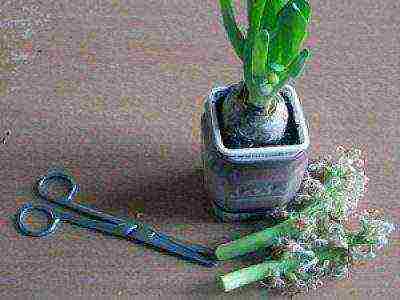 In the budding phase, this representative of the flora is allowed to propagate by leaves.
In the budding phase, this representative of the flora is allowed to propagate by leaves.
You can take 2 leaves from each flower. They are immediately dipped into the heteroauxin mixture. Half a tablet is diluted in 1 liter of water.
It is necessary to keep the leaves in the solution for 6-9 hours.
Then they are planted in containers with a substrate. The soil is mixed with fine-grained sea sand and peat.
Callus should appear on the wound surface after 9-11 days. A month later, the first buds of bulbs appear. After 60 days, young new leaves and a root system should appear on the bulbs. After that, the flower must be transplanted into a nutritious, fortified soil.
One leaf can give from 7 to 10 children.
 The bulbs are cleaned and dried. At the onion, it is necessary to cut off 1/3 of its height. After that, it is divided into 8 equal parts.
The bulbs are cleaned and dried. At the onion, it is necessary to cut off 1/3 of its height. After that, it is divided into 8 equal parts.
It is important that each piece retains a small piece of the bottom.
One large onion can produce up to one hundred paired scales. To disinfect the wounds of the planting material, it is necessary to use crushed charcoal.
Then the planting material is placed in cellophane bags with perlite. Perlite is pre-moistened with 1 drop of a mixture of foundazol. The bags are tied tightly.
After 30 days, callus should appear on the cut line of the scales. It forms tubercles - new embryos of future bulbs. They must again be treated with a foundation and placed in plastic bags.
3-4 months after division, a root system should form in the planting material. Then each bulb is planted in a substrate of fine-grained sea sand. The containers are taken to a cold room.
The substrate must be constantly moisturized. From time to time it is necessary to wait for the topsoil to dry out.
Most read:
Diseases and pests of roses
Disease and harm ...
How to care for an indoor flower: pion-shaped geranium and roses, zonal royal pelargonium ...
Indoor geranium ...
How to properly plant petunia on seedlings, caring for it
How to correctly p ...
Asparagus: care and the main difficulties of growing
Asparagus - oh ...
Liviston palm at home
To the Liviston family ...
What to do if there are midges in orchids, how to get rid of them
Why in the ground ...
From the life of orchids: fertilizers for lush flowering
Orchid thinks ...
Orchid Lady's slipper
Orchid Vienna ...
Cochia: summer cypress in garden design, planting and care
Cochia: summer to ...
Anthurium Scherzer - description, home care, reproduction
Anthurium Scherzer ...
Sparmania (Indoor sticky)
Large openings ...
Mammillaria: photos, types, cultivation and care
Mammill cacti ...
Streptocarpus - care and cultivation from seeds or leaves at home, plant diseases, photos, ...
The beauty is a hybrid ...
Monstera - reproduction in popular ways and features of flower transplant
Monstera - size ...
Money tree (Fat woman) how to care at home
Not everyone knows ...
Palm YUKKA: home care - PHOTO REVIEW!
Introducing uh ...
Dendrobium orchid has faded, what to do next with the plant
If you are ...
Ficus rubber - Ficus elastica: photo, growing conditions, care and reproduction
If you remember ...
Ficus benjamin kinky
Deciduous trees ...
The most unusual flowers in the world TOP 30, Science Debate
Every day we see ...
Hyacinth - home care
Hyacinth (Hyaci ...
Cycad plants, conditions for growing a sago palm at home
Cycad ...
Transplant Guzmania after buying at home
Guzmania before ...
10 unpretentious indoor flowers blooming all year round
10 most unpleasant ...
Gerbera (50 photos of flowers): types and rules of care
Multi-colored g ...
Why Zamioculcas's leaves and flowers turn yellow (photo and video material)
Zamioculcas - ...
Olive tree: home care and maintenance rules
Olive tree ...
Gerbera indoor home care watering and reproduction
Gerbera room ...
On March 8, it is pleasant to receive flowers, and it is more pleasant to receive flowers grown on your own as a gift. For my mother and friend, I decided to grow their favorite hyacinths. And it's good that this decision came in advance, because this procedure is not quick. In this article I will tell you how I did it.
Hyacinth (Hyacinthus) is a bulbous plant. It can be safely grown both in the garden and on the windowsill. Those who want to enjoy the beauty of hyacinth at any time of the year prefer to plant it on a windowsill. But for successful growth, a flower will need suitable conditions and proper care.
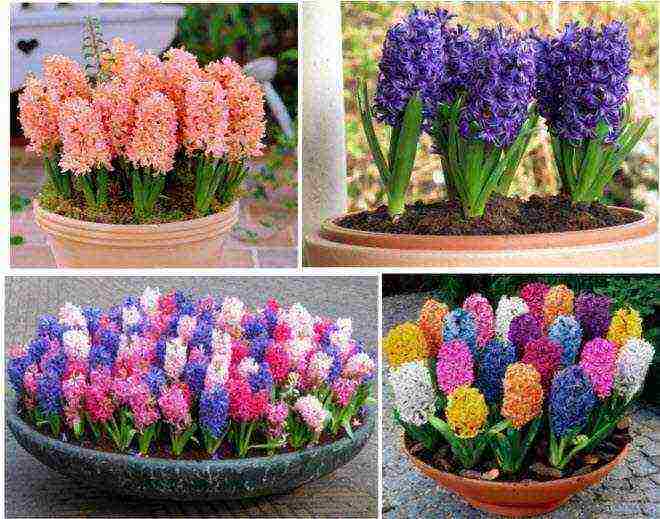
Description
Hyacinth (also found a variant of the name Geocinia) is a member of the asparagus family. It is very popular with flower growers for its extraordinarily beautiful bright colors.
They resemble small bells and are located on a racemose peduncle. The flowers are usually solid. White, blue, purple, light blue, pink or yellow colors predominate.
Hyacinth has 5-8 fleshy and smooth leaves. They grow in the form of a rosette, and a peduncle appears from the socket. The maximum plant height is 30 cm. When blooming, the flowers exude a pleasant and unobtrusive aroma.
When the flower finishes blooming, the leaves begin to die off. Then a new bud will appear on the bulb, from which a new peduncle will appear.
Hyacinth care is not that difficult. Observing all the conditions, a bright blooming miracle will delight you for a long time.

Growing conditions
What conditions will be created for the plant, so it will grow and develop. For home breeding, hyacinth requires the following conditions:
Temperature regime
During rooting, the recommended temperature is no more than 5 ° C. When the first shoots appear, the room temperature should be raised to 12 ° C. When the buds appear, the flower is placed in a place where it will constantly grow. Here you need to maintain a strictly defined temperature level of 18оС.
Drafts and sudden temperature changes are unacceptable for hyacinth. This will harm growth and flowering.
Hyacinth is a moisture-loving plant. His soil should always be moist. Air humidity must be at the required level.
Lighting
Having planted the bulbs in the ground, the pot is removed in complete darkness for 2 months. Over time, when the stems have already appeared, the pot can be placed in the shade or partial shade.
With the appearance of buds, the pot is placed where there is a lot of light. It is recommended that the plant be periodically turned in different directions so that the development proceeds uniformly.
In cloudy weather, as well as on short daylight hours, you can use additional lighting.
It is necessary to remove the plant for a while in a dark place so that later its development will take place harmoniously. If you get it out of a dark place earlier than it should, it may still be weak and grow poorly. Overexposure is also harmful. All forces will go into the foliage, and the buds will form very slowly.
Preparing the soil
Fertile soil is very important for hyacinth. It should be neutral in acidity and high in organic matter. A peat-sandy substrate is also suitable.
There must be a drainage layer at the bottom. Ordinary moss works well for its creation. Thanks to him, the soil will become more loose and moisture-consuming.
Growing rules
So that hyacinth can delight with its flowering and fragrant appearance, some rules for its correct cultivation are important.
Cooking the onions
To grow a strong and sturdy plant, you need to select the planting material. Experienced growers advise planting bulbs at least 5 cm in diameter. Only from these can full-fledged flowers grow. Also inspect each specimen for rot and other defects.Treat with a disinfectant just before planting.
Landing features
- It is recommended to plant 1 to 3 bulbs in a pot;
- The bulbs should be close to each other, no more than 2 cm apart.
- Lay out drainage at the bottom, then add soil with the addition of sand;
- Arrange the bulbs and press in slightly, but the top of the bulbs should remain above the ground.

Watering
The soil in the hyacinth pot should be moistened, but the plant will not tolerate stagnant water. This usually leads to root rot.
The pot has a drain to maintain the optimal moisture level, and the rest of the water remaining after watering should be drained. The irrigation process is treated carefully and carefully so that water falls only on the ground.
Top dressing
Since hyacinth absorbs soil nutrients well and the soil is quickly depleted, it is worthwhile to fertilize periodically.
For better preservation of the bulbs, while they are in a sleepy state, they are sprayed with a weak solution of fertilizers with a high content of potassium and phosphorus.
When hyacinth is in bloom, it is fed every 2 weeks to stimulate growth.
Distillation
In order for your "handsome men" to bloom at a certain time, for example, for a holiday, you can hold the so-called distillation. There are 3 types of forcing hyacinths:
- Early - flowering begins by the end of the year, for this, planting is carried out in October;
- Medium - will bloom by the end of January-early February, landing in November;
- Late - will bloom in March-April, disembarkation in December.
For successful distillation, the bulbs are prepared by leaving them for every 2 weeks in rooms where the temperature drops. After digging out the bulbs from the ground, store for 14 days in a warm and humid room at 28-30 ° C. Further for 2 weeks 22-25оС. Then 15-17 ° C. After these 6 weeks, the bulbs can be planted.
Remember that hyacinth does not bloom for several years in a row, especially after distillation. In order for the plant to rest, you need to plant it in open ground for 1-2 seasons.
What to do when the bloom ends
To prolong the life of a faded hyacinth, the peduncle is cut off. Fertilizing and watering at this time is not advised. Over the course of some time, the main bulb will recover and daughter ones are formed.
After the entire aerial part of the bulb has dried, it must be removed from the soil, remove the remaining leaves and dry within 2-3 days. Next, plant the main old bulb in the garden, and new young shoots in a new pot.
Reproduction
Hyacinth multiplies with the help of children. They come from the parent bulb. For 1 year under natural conditions, up to 4 new shoots grow from one copy.
In order not to wait for children for a whole year, they use an artificial method. It consists in cutting and notching the bottom. Thanks to this, more children are formed.
It is important to disinfect the bulbs before this procedure. They are treated with potassium permanganate (1% solution) and dried for several days.
Cutting the bottom
This procedure is carried out during the period when the bulb is rested.
- Cut out the bottom with a teaspoon;
- Fold them into a container with the cutout up;
- The air temperature is not lower than 21 ° C;
- After 60-90 days, babies will begin to form, about 20-40 pieces;
- Plant the onion with shoots in a cool closed container so that the children begin to grow and give the first leaves;
- After the growing season, remove the bulb, separate the shoots and plant to grow.
Such bulbs will bloom after 3 years.
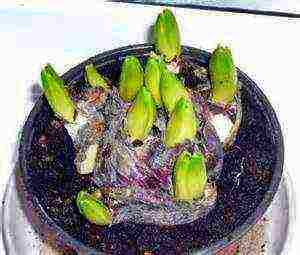
Notching the bottom
This method is similar to cutting. Several cuts of 5 mm are made in the bottom. The next steps are exactly the same. So the number of children will be less (7-15 pcs.), But they will be stronger and stronger. The growing period will be approximately 2-3 years.
Pests and diseases
Although hyacinth is very resistant to diseases and pests, they can still find a weak spot in the plant and infect it.
- Bacterial rot - the symptoms of infection are very different, including rotting or drying of the roots, blackheads, etc.You cannot cope with this disease yourself. The only solution is to destroy the plant with soil and disinfect the pot.
- Insects are harmful, especially spider mites, aphids, etc. To kill them, insecticides are used, but they cannot be used when the plant is in bloom.
It is not so easy to grow hyacinths at home, but there are also no extraordinary difficulties. With a properly built system for the care and cultivation of flowers, you will get gorgeous flowering plants with a pleasant and delicate aroma.
Tell me how to transplant hyacinth? After the spring holidays, I still have a pot with a gift flower, all the leaves have already wilted long ago. I would like to keep it, the variety is very beautiful. And my garden hyacinths, planted two years ago, have never moved and have already formed whole thickets. I think it's time to thin them out, but I just don't know how to do it right.
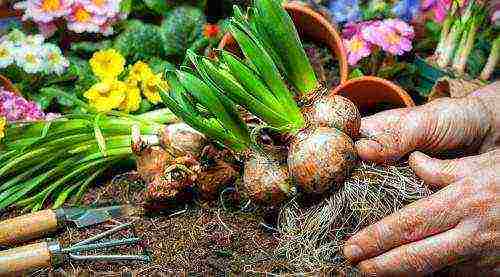 All the beauty of the hyacinth lies in its peduncle - lush and dense, with large flowers, it appears in early spring one of the first. In order for the flowering to remain the same colorful, and the sizes of the inflorescences are not crushed, it is important to know how to transplant the hyacinth. This applies to both indoor and garden specimens. Why? Over time, the bulb of indoor hyacinth becomes larger and larger, becomes overgrown with children and all of them become cramped in the pot.
All the beauty of the hyacinth lies in its peduncle - lush and dense, with large flowers, it appears in early spring one of the first. In order for the flowering to remain the same colorful, and the sizes of the inflorescences are not crushed, it is important to know how to transplant the hyacinth. This applies to both indoor and garden specimens. Why? Over time, the bulb of indoor hyacinth becomes larger and larger, becomes overgrown with children and all of them become cramped in the pot.
Garden hyacinths have more room to grow. However, despite this, they begin to hurt without a transplant, since various bacteria accumulate in the soil. Thus, transplanting is an important part of growing hyacinths, influencing not only their flowering, but also their overall development.
Features of transplanting indoor hyacinths
Hyacinths growing in pots on windowsills need not be touched as long as they have room to grow. When the onion begins to clearly protrude from the flowerpot, it can and should be transplanted into a new container.
It is necessary to transplant these indoor plants in early autumn, because hyacinths are originally a horticultural crop. Even when growing them indoors, you should adhere to the natural development cycle.
The transplant process itself is as follows:
- carefully remove the onion from the flowerpot, trying to damage the roots as little as possible;
- pick up a pot that should be slightly larger in diameter than the bulb itself (about 5 cm);
- lay drainage in it;
- top up with nutritious soil for bulbous plants;
- cover the ground with a thin layer of sand;
- place the onion in the center and cover it with soil, leaving a top about 1.5 cm high above the soil level.
If the hyacinth has babies, they must be separated and planted separately in small pots.
After the transplant, it is better to put the flowerpot with hyacinth in the dark and cool (no higher than 10 degrees Celsius). It will remain there until the bulb releases new shoots. Then the flower can be transferred to a lighter and warmer room.
How to transplant garden hyacinth?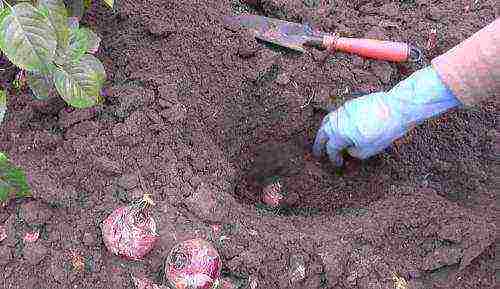
Before September, there is no point in replanting hyacinths growing in the garden. Firstly, if you hurry, then the bulb will wake up ahead of time and begin to germinate. Secondly, late planting will not leave her rooting time. In both cases, the ending will be the same - it will freeze at the very first frost.
About a month before transplanting, you need to start preparing a new place for the flower. It should be bright, quiet and sunny. It is advisable to add to the site:
- coarse sand;
- ash;
- compost.
The dug out hyacinths should be shaken off the old soil and disinfected in a solution of potassium permanganate. Make shallow holes in the flowerbed and plant bulbs in them.
Garden hyacinths should not be left above the soil. On the contrary, the bulbs must be safely hidden underground, but without fanaticism. An adult bulb deepens by 15 cm, small children are located closer to the surface.And finally, the final stage of transplanting will be mulching with sawdust or foliage. This blanket will protect the hyacinths from winter frost.
Hyacinth cultivation video
